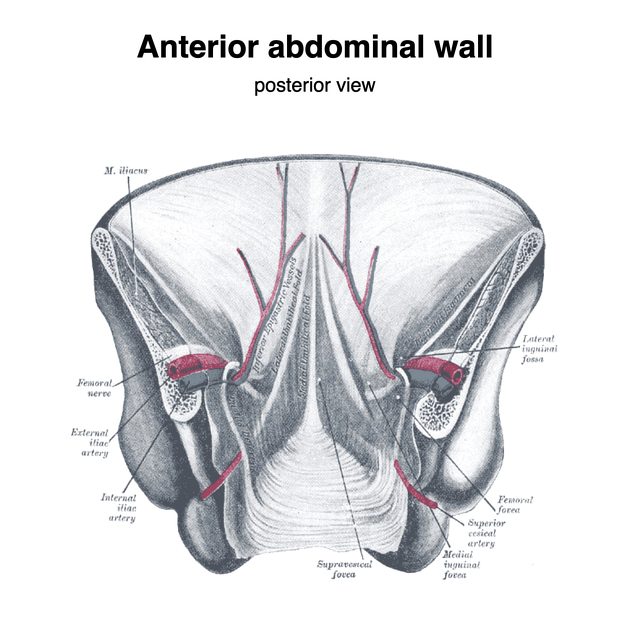The anterior abdominal wall forms the anterior limit of the abdominal viscera and is defined superiorly by the xiphoid process of the sternum and costal cartilages and inferiorly by the iliac crest and pubic bones of the pelvis.
On this page:
Gross anatomy
In general, the anterior abdominal wall has nine layers (from superficial to deep) 4:
subcutaneous fat (Camper's fascia)
Scarpa's fascia is deep to the skin and subcutaneous fat in the lower part of the wall. It is continuous with fascia lata of the thigh, Colles fascia of the perineum and Dartos fascia of the penis, scrotum and labia.
The muscle layers include the external oblique muscle, internal oblique muscle, transversus abdominis muscle anterolaterally and the rectus abdominis muscle anteriorly. The fascia surrounding the three anterolateral muscles fuse anteriorly to attach to the rectus abdominis at the linea semilunaris. The fascia then continues medially surrounding the rectus abdominis as the rectus sheath further fusing in the midline with the contralateral fascia at the linea alba. Thus the combination of muscle, aponeuroses, and fascial layers form a corset-like structure that protects the abdominal viscera.
The arcuate line demarcates an important boundary on the anterior abdominal wall as the inferior limit of the rectus sheath. Superior to the arcuate line, the internal oblique aponeurosis surrounds the rectus abdominis muscle on its anterior and posterior aspects. Inferior to the arcuate line, the aponeuroses of internal oblique and transversus abdominis fuse and pass anteriorly to the rectus abdominis muscle.
Arterial supply
The muscles and associated soft tissues derive blood supply from branches of the superior epigastric, subcostal and inferior epigastric arteries and their cutaneous branches above the umbilicus 4.
Arterial supply below the umbilicus is from superficial epigastric arteries, superficial circumflex iliac arteries and superficial external pudendal arteries.
Venous drainage
Superficial veins are paired with the arteries. Veins above the umbilicus drain into the axillary vein via lateral thoracic vein and below the umbilicus into the femoral system via the superficial epigastric vein into the great saphenous vein.
A few paraumbilical veins pass deep from the umbilical region to anastomose with the portal vein (via ligamentum teres).
Lymphatic drainage
The lymphatic vessels above the umbilicus drain into axillary and sternal nodes. The vessels below the umbilicus drain into superficial inguinal nodes.
Innervation
Derived from the ventral rami of T7 through L1. Thoracoabdominal nerves from the ventral rami of T7 to T11. Subcostal nerves from the ventral rami of T12. Ventral rami of the L1 nerve roots give rise to iliohypogastric and ilioinguinal nerves 4.
Variant anatomy
variable level of the arcuate line
variable number of horizontal septations in rectus abdominis
presence (or absence) of pyramidalis and/or rectus sternalis muscles
presence (or absence) of superficial inferior epigastric artery supplying superficial tissues of abdominal wall below the level of the umbilicus
Radiographic features
Plain radiograph
Muscle layers of the anterior abdominal wall may be outlined between the extraperitoneal fat and subcutaneous fat layers, especially in obese patients.
CT
Three muscle layers (external oblique, internal oblique, transverse abdominis) can be seen anterolaterally in cross-section and also the rectus abdominis muscle and its sheath can be seen anterior to the other three muscle layers.









 Unable to process the form. Check for errors and try again.
Unable to process the form. Check for errors and try again.